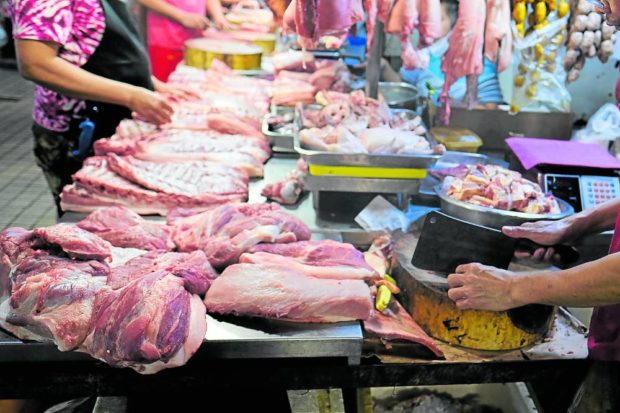
SELLING PROTEIN Meat vendors at Farmers Market in Cubao during the 2022 Christmas season. —GRIG C. MONTEGRANDE
The volume of meat sourced overseas by the Philippines declined in January as the country now prefers imported chicken over pork and beef, based on the data from the Bureau of Animal Industry (BAI).
Meat imports reached 76.52 million kilograms (kg) last month, a decrease of 10.83 percent from 85.81 million kg in January last year.
Likewise, the volume marked a decline of 26.55 percent from the 104.19 million kg of imported meat that arrived last December.
Chicken eclipsed pork as the main driver of meat imports with a volume of 30.33 million kg, comprising 39.64 percent of total. Most of these were mechanically deboned chicken and mechanically separated chicken, followed by chicken leg quarter.
However, this was 22.27 percent lower than 39.02 million kg sourced in the previous month.
Pork imports ranked a close second with 30.27 million kg, down by 34.47 percent from 46.2 million kg previously. Offals and pork cuts accounted for more than a third of imported pork.
The country procured 12.51 million kg of beef abroad, primarily beef cuts. Moreover, the country imported 3.33 million kg of buffalo.
The BAI data recorded small quantities of imported duck, lamb and turkey bought during the reference period.
Trading partners
Brazil remained the country’s primary source of meat imports with 24.65 million kg, mostly chicken.
The United States followed with 13.79 million, mostly chicken and Spain with 8.85 million, primarily pork.
The US Department of Agriculture (USDA) earlier said it was expecting the Philippines to continue sourcing more pork as the Marcos administration extended the validity of lower import tariffs until end-2023.
The foreign agency had estimated that pork imports would reach 600,000 metric tons this year, an increase of 4.3 percent.
Executive Order No. 10, signed by President Marcos in December last year, retained the “most favored nation” rates on fresh, chilled, or frozen meat at 15 percent (in-quota) and 25 percent (out-quota) effective until end-2023.
The USDA also estimated local production to hit 1 million metric tons this year with bigger pigs expected to be produced as the industry “sees a glimmer of hope because of the special permit application for an ASF (African swine fever) vaccine by a local company before the Food and Drug Administration.” INQ

